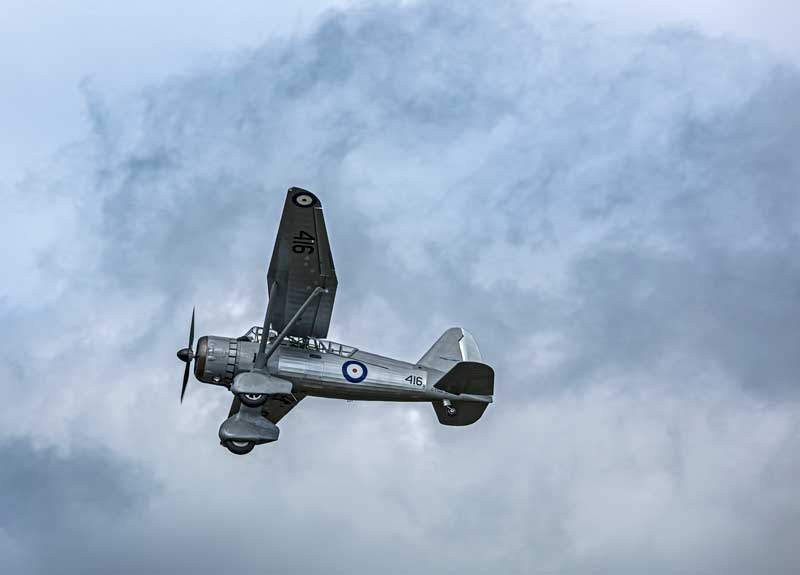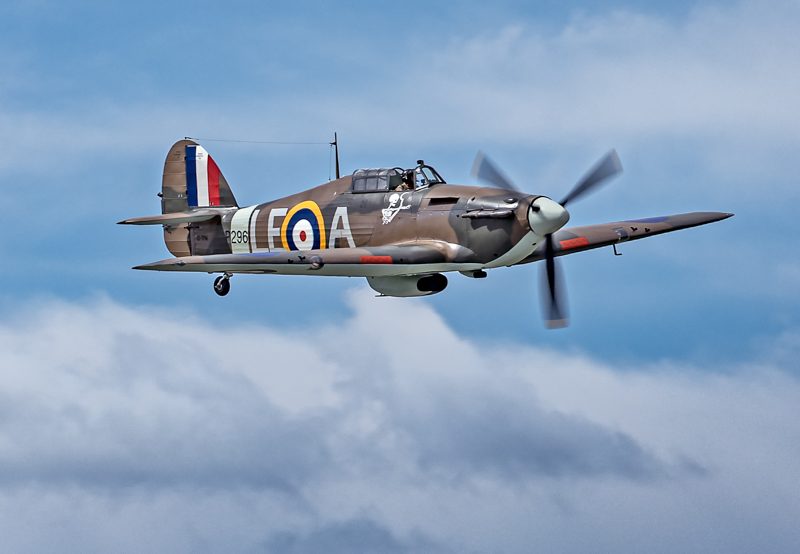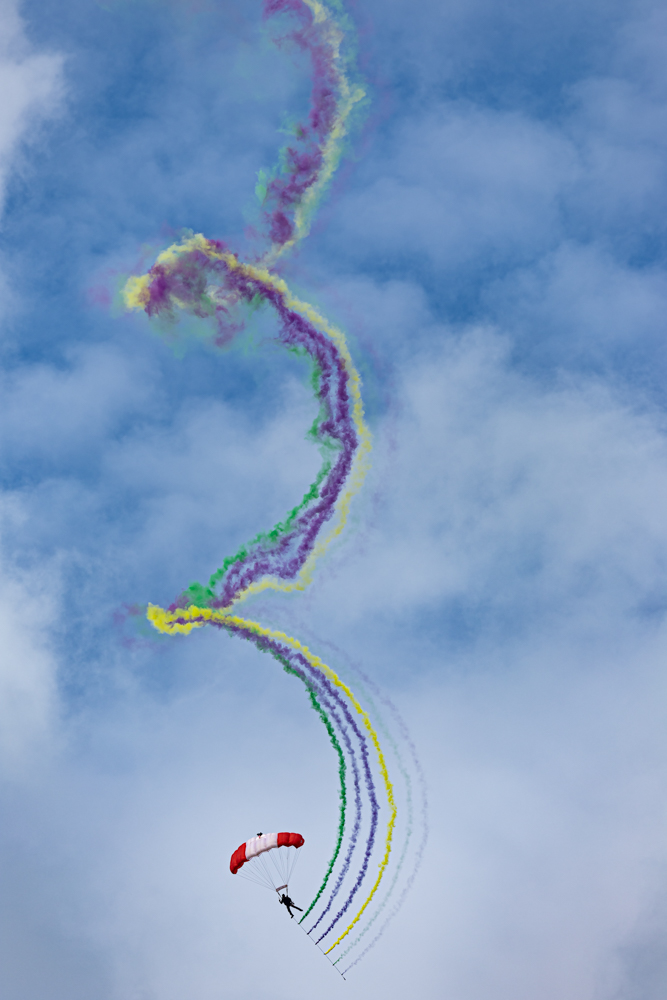Flight is a beautiful thing, whether by bird’s wing or by human hand.
They are different, to be sure.
The power and majesty of the mighty eagle, the agility and speed of the osprey, the silence and efficiency of the great grey have been a central focus of my photography beyond work, a diversion from the rigours of daily life.
Aviation, on the other hand, has been a lifelong interest. My dad was air force during the Second World War, and so I was raised on stories of the Hurricane and Spitfire, the P-51 Mustang and the P-47 Thunderbolt, the Lancaster and the B-17.
I worked a year after high school flying with Vietnam-era helicopter pilots on oil exploration crews all across northwestern Alberta, northern British Columbia and the Arctic.
I saved enough to earn my private pilot’s licence, and I flew throughout my college years, taking classmates up for jaunts over Nova Scotia’s Cape Blomidon and around the Annapolis Valley. They paid the rentals; I logged the hours.
Now, I photograph warbirds and wild birds at every opportunity. Aero Gatineau-Ottawa, the annual airshow staged out of the Gatineau, Que., executive airport, attracts tens of thousands of attendees, who come to watch vintage and not-so-vintage aircraft and performers from all across Canada and the United States.
For me, and a host of others, it’s an opportunity to marry art with aviation, history with high flight and, if the weather co-operates, find a warbird or two among the cloudscapes that maybe, just maybe, evokes the paintings of Robert Taylor.

The North American TF-51D Mustang The Little Witch awaits its day’s work at Aero Gatineau-Ottawa. A 1950s-era veteran of 420 Squadron, Royal Canadian Air Force, based in London, Ont., the plane is owned and flown by Ariel Luedi of Kissimmee, Fla. [Stephen J Thorne 2022 All Rights Reserved]

Vintage Wings chief pilot Dave Hadfield is on the stick of the Supermarine Spitfire Mk IX, often touted as the most beautiful airplane ever built. More than 22,000 Spits were built in nearly 30 variants, including the Seafire, a carrier-based fighter of Britain’s Fleet Air Arm. The Spit is the only fighter aircraft of the Second World War that was in continuous production before, during and after the conflict.[Stephen J Thorne 2022 All Rights Reserved]

The Skyhawks, the Canadian military’s elite parachute demonstration team, do what they do. [Stephen J Thorne 2022 All Rights Reserved]

The Little Witch, flown by owner/pilot Ariel Luedi gleams in the afternoon light. The definitive version of the North American P-51D Mustang was powered by the Packard V-1650-7, a licence-built version of the two-speed, two-stage-supercharged Merlin 66. It was armed with six .50-caliber AN/M2 Browning machine guns and made for a formidable air- and ground-attack fighter.[Stephen J Thorne 2022 All Rights Reserved]

Vintage Wings pilot Joe Cosmano taxies the newly restored Hawker Hurricane Mk XII out to the runway at the Gatineau executive airport. The aircraft was built by Canadian Car and Foundry in Fort William, Ont.–one of 14,487 built in Britain, Canada, Belgium and Yugoslavia between 1936 and 1944. [Stephen J Thorne 2022 All Rights Reserved]

The Hurricane was a stalwart of the Battle of Britain, providing a tough and steady gun platform to take down German bombers while the faster and more agile Spitfire contended mainly with the Luftwaffe fighters.[Stephen J Thorne 2022 All Rights Reserved]

The Westland Lysander started out the Second World War as an artillery spotter and a reconnaissance aircraft. But it evolved into one of the more fascinating aircraft of the war, using its superb short takeoff and landing capabilities to deliver spies and equipment to French Resistance forces. Lysanders were operated in and out of unprepared fields, pastures and forest clearings in the dark of night and often in less-than-ideal weather.[Stephen J Thorne 2022 All Rights Reserved]

Vintage Wings chief pilot Dave Hadfield puts the Lysander IIIa through its paces.[Stephen J Thorne 2022 All Rights Reserved]

From late 1943, P-51s were equipped with drop tanks, providing them with enough fuel to escort bombers of the U.S. Army Air Forces’ Eighth Air Force in raids over Germany. The RAF’s Second Tactical Air Force and the USAAFs Ninth Air Force used the Merlin-powered Mustangs as fighter-bombers. The P-51 was also used by Allied air forces in the North African, Mediterranean, Italian, and Pacific theatres. Mustang pilots claimed 4,950 kills during the war.[Stephen J Thorne 2022 All Rights Reserved]

Owner/pilot Louis Horschel is on the stick in the TF-51D Mustang Mad Max, painted in the livery of Major Sam Brown, an ace of the 307th Fighter Squadron, 31st Fighter Group, 15th Air Force, USAAF. Brown chalked up 15.5 kills between April 14 and July 26, 1944. [Stephen J Thorne 2022 All Rights Reserved]

“Little Witch” is painted in the livery of the 353rd Fighter Group, 253nd Fighter Squadron, USAAF. [Stephen J Thorne 2022 All Rights Reserved]

The skin of a vintage fighter aircraft is thin and flexible to the air around it, and it’s stained with exhaust.[Stephen J Thorne 2022 All Rights Reserved]

In sync. Mustangs Mad Max (foreground) and The Little Witch make their return. [Stephen J Thorne 2022 All Rights Reserved]

The Hurricane entered squadron service on Dec. 25, 1937. It used conventional construction methods so squadrons could perform many major repairs without outside support. By September 1939, the RAF had 18 Hurricane-equipped squadrons in service.[Stephen J Thorne 2022 All Rights Reserved]

This Hawker Hurricane Mk XII, part of the Michael Potter Collection at Vintage Wings of Canada, was built in Fort William, Ont., and is painted in the colours of Flying Officer William Lidstone (Willie) McKnight, an Alberta native who served with 242 (All Canadian) Squadron, Royal Air Force. McKnight, a recipient of the Distinguished Flying Cross and bar, fought in the Battle of France, Dunkirk and the Battle of Britain before he was lost without a trace in a January 1941 engagement over the English Channel.[Stephen J. Thorne 2022 All Rights Reserved]

The undersides of Hurricane wings were painted black to port and white or grey/blue to starboard in 1939-40 to aid recognition from the ground. The practice was abandoned in August 1940 and the undersides were subsequently painted sky blue. [Stephen J. Thorne 2022 All Rights Reserved]

Dave Hadfield brings the Spitfire in. The Rolls Royce Merlin-powered Mk IX is painted in the livery of Arnold Roseland, a Canadian who flew 442 Squadrons Y2-K aircraft more than 65 times before he was shot down and killed over Normandy in 1944. [Stephen J. Thorne 2022 All Rights Reserved]

The Spitfire Mk IX is oft-considered the best of nearly 30 variants produced between 1936 and 1948. About 70 Spits are still flying worldwide. [Stephen J. Thorne 2022 All Rights Reserved]

The Vintage Wings Spitfire Mk IX in D-Day invasion stripes.[Stephen J. Thorne 2022 All Rights Reserved]

The Spitfire is arguably the most iconic aircraft of the Second World War.[Stephen J. Thorne 2022 All Rights Reserved]

A master of graceful flight, a turkey vulture makes a pass over airshow spectators. [Stephen J. Thorne 2022 All Rights Reserved]

The PZL-104 Wilga is a Polish short-takeoff-and-landing (STOL) utility aircraft designed and originally manufactured by PZL Warszawa-Okęcie, and later by European Aeronautic Defence and Space Company. It was first flown in April 1962. Military air services typically used it as a trainer and liaison aircraft. More than 1,000 were built before it went out of production in 2006. [Stephen J. Thorne 2022 All Rights Reserved]

A member of the CAF Skyhawks demonstration team spends another afternoon at work.[Stephen J. Thorne 2022 All Rights Reserved]

Big sky; big aircraft. Nearly 50,000 Allied pilots qualified on the North American Harvard at WW II air training bases across Canada as part of the British Commonwealth Air Training Plan.[Stephen J Thorne 2022 All Rights Reserved]

The Vintage Wings of Canada Harvard Mk IV is painted in the unique markings of a Harvard known to have been flown by anglo-American Pilot Officer John Gillespie Magee when he was in Service Flying Training at No. 2 SFTS Uplands in Ottawa. Magee penned the iconic poem High Flight before he was killed in a mid-air collision over England in 1941.[Stephen J Thorne 2022 All Rights Reserved]

The Fleet Finch was a mainstay of RCAF training in the 1930s and the early part of the Second World War. Just over 600 Model 16s (pictured) were produced, most of them for the RCAF. They were used as initial trainers in the British Commonwealth Air Training Plan at a dozen elementary flight training schools across Canada. The Finch was completely phased out of service by 1947. [Stephen J Thorne 2022 All Rights Reserved]

This De Havilland DH-83 Fox Moth was first owned by HRH Edward, Prince of Wales, in 1932 and operated by the Royal Flight for about a year. The forward cabin is fitted out with burgundy leather and matching folding wooden tables. [Stephen J Thorne 2022 All Rights Reserved]

The plane moved to New Zealand in 1936, where it pioneered airline routes primarily in the mountainous south. It crashed on the Franz Josef glacier in 1943 and was later rebuilt, operating in regular airline service until 1953. It became a crop sprayer before it was taken to Fiji in 1957. The tropical climate deteriorated the wood structure and the aircraft was derelict by 1960. The remains were returned to NZ and restored in 1993 by Colin Smith of Croydon Aircraft.[Stephen J Thorne 2022 All Rights Reserved]

Pilot Ariel Luedi takes to the air in The Little Witch, a P-51D Mustang. This particular aircraft was originally with 420 Squadron, RCAF.[Stephen J Thorne 2022 All Rights Reserved]

Ariel Luedi in The Little Witch (left) and Louis Horschel in Mad Max take their Mustangs for a loop.[Stephen J Thorne 2022 All Rights Reserved]

From late 1943, P-51s were equipped with drop tanks, providing them with fuel enough to escort bombers of the USAAF’s Eighth Air Force in raids over Germany. The RAF’s Second Tactical Air Force and the USAAF’s Ninth Air Force used the Merlin-powered Mustangs as fighter-bombers.. The P-51 was also used by Allied air forces in the North African, Mediterranean, Italian, and Pacific theatres. Mustang pilots claimed 4,950 kills during the war. [Stephen J Thorne 2022 All Rights Reserved]

T-33 Silver Star Pilot Bill Culbertson makes a pass at Aero Gatineau-Ottawa 2022. More than 6,500 T-33s were produced by Lockheed between 1948 and 1959. The plane’s Nene 10 engine was copied by the Soviets and is the same engine used in the MiG-15, MiG-17 and several other early-generation Soviet jets.[Stephen J Thorne 2022 All Rights Reserved]

Skyhawks hump their gear back to the staging area post-jump. [Stephen J Thorne 2022 All Rights Reserved]

Master Corporal Marc Dumaine of Dieppe, N.B., an air drop system tech out of Trenton, Ont., is about to repack his chute after jumping with the CAF’s Skyhawks demonstration team.[Stephen J Thorne 2022 All Rights Reserved]

Warrant Officer Eric Demers of Chany, Que., a paratrooper from the Royal 22e Régiment(Vandoos), packs his chute after a performance with the Skyhawks demonstration team. The team consists of both permanent members and temporary members from the regular and reserve forces. [Stephen J Thorne 2022 All Rights Reserved]

The Canadian military’s Skyhawks demonstration team perform. [Stephen J Thorne 2022 All Rights Reserved]

Master Corporal Marc Dumaine of Dieppe, N.B., an air drop system tech out of Trenton, Ont., repacks his chute after jumping with the CAF’s Skyhawks demonstration team. [Stephen J. Thorne 2022 All Rights Reserved]

Members of the CAF Skyhawks demonstration team pack their parachutes after a performance at Aero Gatineau-Ottawa 2022. [Stephen J. Thorne 2022 All Rights Reserved]

RCAF Captain Jesse Haggart-Smith, call sign “Modem,” climbs out in his CF-18. The McDonnell Douglas aircraft went into service with the Canadian military in 1982 and is expected to be replaced by the Lockheed Martin F-35A. [Stephen J. Thorne 2022 All Rights Reserved]

RCAF Capt. Jesse Haggart-Smith, call sign “Modem,” puts his CF-18 through its paces. The McDonnell Douglas aircraft went into service with the Canadian military in 1982 and is expected to be replaced by the Lockheed Martin F-35A. [Stephen J. Thorne 2022 All Rights Reserved]

RCAF Capt. Jesse Haggart-Smith, call sign “Modem,” kicks in the afterburners on his CF-18. [Stephen J. Thorne 2022 All Rights Reserved]

Distinguished by its wide wingspan and large rear-mounted engines, the single-seat Warthog is highly maneuverable. It’s also a deadly killer, equipped with one of the most powerful aircraft cannons ever flown — a 30×173 mm GAU-8/A Avenger autocannon. It fires large depleted uranium armor-piercing shells. Its hydraulically driven, seven-barrel rotary cannon is designed specifically for the anti-tank role with a high rate of fire. Its original design could be switched by the pilot to 2,100 or 4,200 rounds per minute; this was later changed to a fixed rate of 3,900 rounds per minute. [Stephen J. Thorne 2022
All Rights Reserved]

The A-10 has been among the most resilient and effective aircraft of the post-WW II era. [Stephen J. Thorne 2022 All Rights Reserved]

Ther Fairchild Republic A-10 Thunderbolt, nicknamed the “Warthog” and known as a tank killer, is a close-support aircraft. It takes its formal name from the P-47 Thunderbolt, a WW II fighter-bomber that had a similar reputation for toughness and effectiveness. Production on the A-10 ceased in 1984, but it served in Afghanistan and is still flying operations. Experts say its service life can extend through 2040. [Stephen J. Thorne 2022 All Rights Reserved]

Major Haden (Gator) Fullam brings his USAF A-10C Warthog in after a demonstration flight at Aero Gatineau-Ottawa 2022. The close air support aircraft, built by Fairchild Republic Co., has been in service since 1976 and still packs a formidable punch. [Stephen J. Thorne 2022 All Rights Reserved]
Advertisement


































